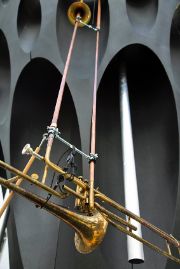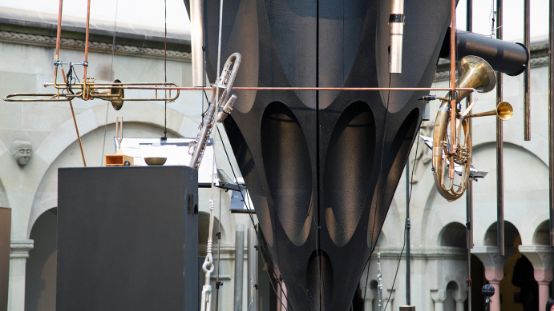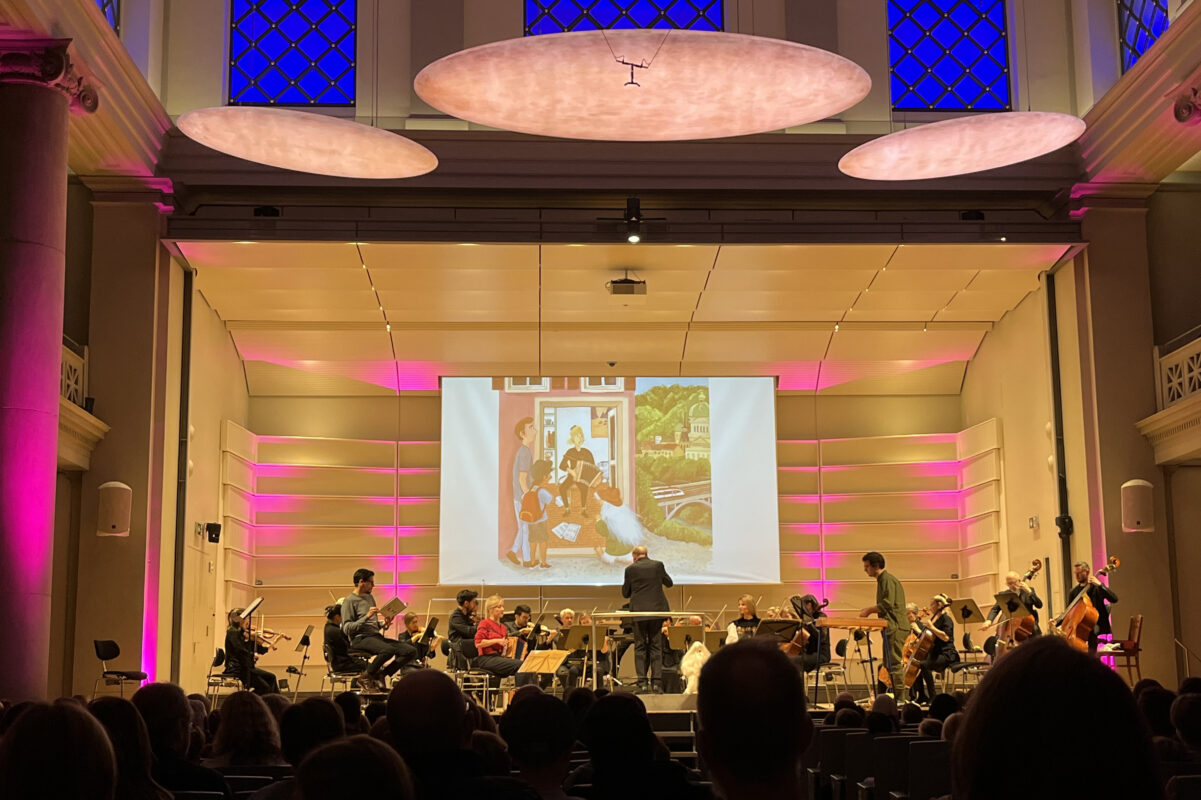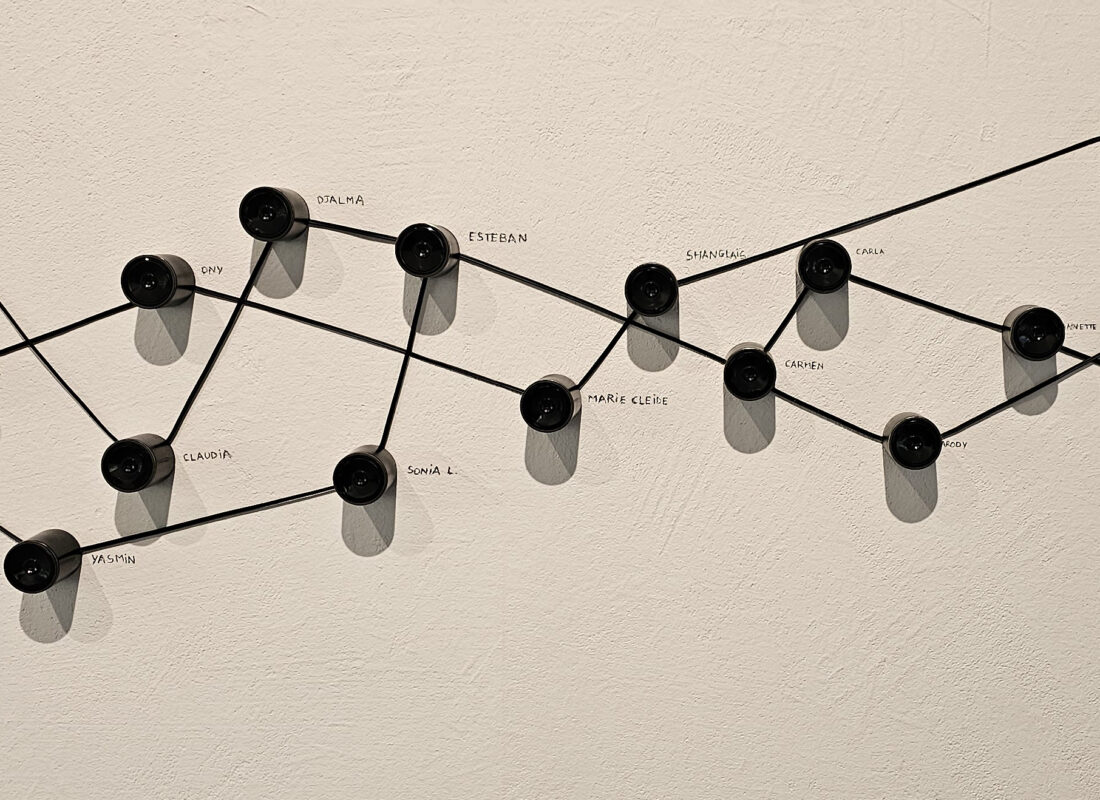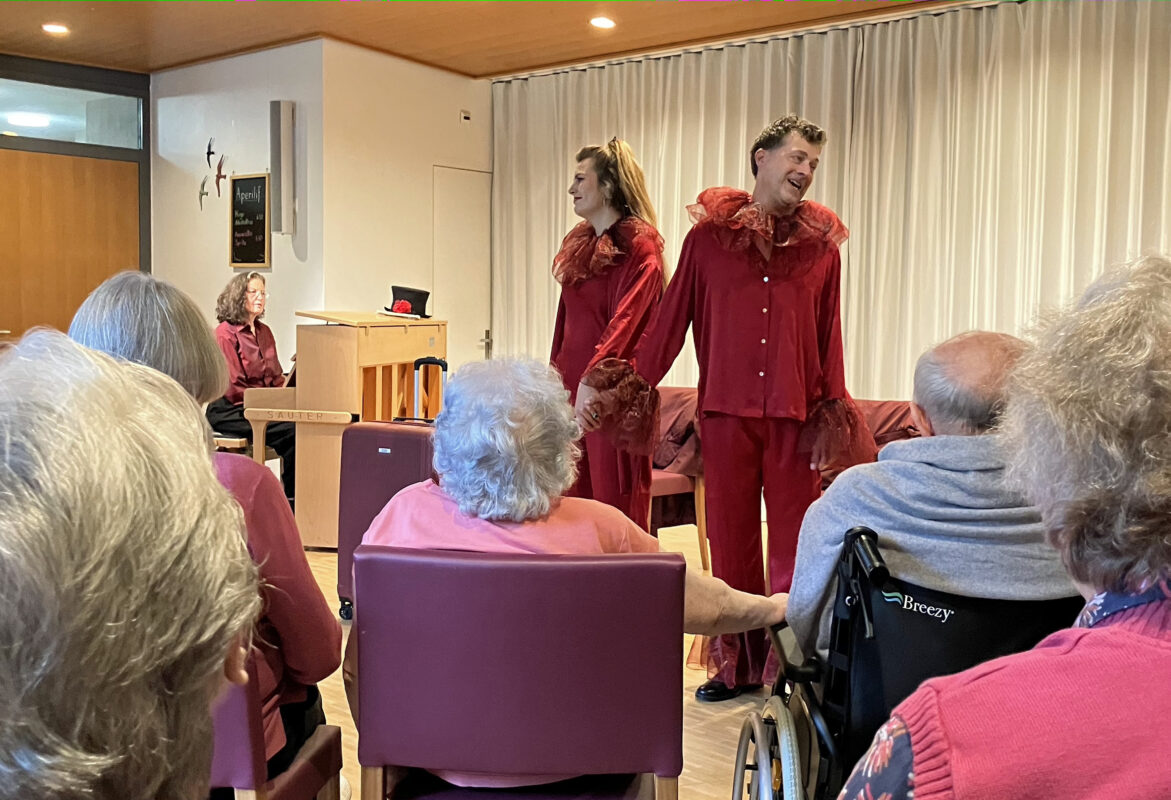A giant pipe as a pointer
The Musikpodium is bringing the production "Rohrwerk" by Studio-Klangraum to Zurich, thus clearly marking where the music is playing.

Music is a contemporary art - or at least is generally regarded as such. However, it is often forgotten that it not only develops in time, but also requires space in order to expand. Designed space, on the other hand, is the domain of architecture, a profession that is strangely indifferent, even deaf, to the sphere of sound in the routine that characterizes everyday life.
Music and architecture - bringing these two estranged sisters closer together is the aim of composer and Studio Klangraum co-founder Beat Gysin. And with the project Reed mill. Fabrique sonore this happens in the most spectacular way imaginable. A 45-metre high fabric tube is held by a crane in the cloister of the Grossmünster. The "arrowhead" of this tube points downwards, the futuristic-looking monster appears to stand on an area of just a few square centimetres. Never-before-seen percussion and wind instruments are built into the tip, which has wave-shaped cut-outs: extra-long tubular bells, a horn connected to a trombone, a sound tube with the longest spring in Switzerland as a pulse generator, tubes that serve as loudspeakers but can also generate a feedback loop ...
Gigantic teamwork
These wonders of sound were developed as a team effort. The conventional division of labor between composer, musician, stage designer, organizer, etc. played no role in this project. 2019 as part of the ZeitRäume Basel festival project, which was realized for the first time, played a subordinate role. Together, around a large table, the participants from all sectors hatched their misshapen egg. The impetus for Pipe mill came from the Studio sound roomit is actually already the third episode of a Lightweight constructions series of spatial and musical interventions. But such an undertaking could never be realized without the intensive cooperation of all those involved, their enthusiasm and also their insanity. So it is only logical that the giant pipe was not only placed in the skyline of Zurich and played with music composed especially for it. Workshops with the composers and guided tours with stage designer Peter Affentranger and architect Patrick Heiz were held throughout the weekend from June 25 to 27. Not only did this open up unusual insights and perspectives, it was also simply beautiful. For example, when the two percussionists Anne Briset and Jeanne Larrouturou proudly presented the arsenal of sonic wonder doors they helped to develop.
For Pipe mill no expense was spared in Zurich. As the Institute for Computer Music and Sound Technology (ICST) at Zurich University of the Arts (ZHdK) was involved as co-producer, this is not really surprising. Nevertheless, the Musikpodium of the city of Zurich usually bakes much smaller rolls. It is easy to assume that the Musikpodium wants to make its presence felt at the new Sonic Matter festival, the successor project to the Tage für Neue Musik, and therefore wants to stir things up with a giant ladle. But Heinrich Mätzener, the artistic director of the Musikpodium, immediately brushes such considerations aside. The two events are completely independent of each other. He and René Karlen, the then head of the city's serious music department, simply agreed immediately to support the unique project. That was over two years ago, when Sonic Matter and Covid were not yet an issue. And it was only because of the latter that Pipe mill only just arrived in Zurich.
The discomfort of music in space
But all superlatives of height, width and length aside: Is the giant pipe also musically convincing? There were three concerts, the one on Saturday with compositions by Emilio Guim, Beat Gysin and the two ICST musicians Germán Toro Pérez and Nicolas Buzzi. And yes, the concerts were a joy. The inner courtyard of the cloister was flooded with static music, the likes of which had probably never before been heard in these venerable walls. Overtone spectra were fanned out, sound surfaces were built up and then torn down again. It was never immediately clear whether the sounds were analog or electronically produced or reproduced. In any case, it was worth paying close attention to who was working on what on stage. And although all the composers worked with overtones, i.e. all the pieces came from the same sound world, there was no feeling of uniformity. However, one could criticize the fact that one could imagine all the pieces without the whole giant construction. It would be no problem to hang all the wacky instruments on oversized Ikea clothes racks without any musical loss. The connection between the construction and the music was not recognizable enough.
But this is perhaps the most interesting thing about Pipe mill. The discrepancy between architectural effort and musical necessity highlights the problem of space in music. The brief given to the Geneva team of architects Made in at the start of the project can be summarized as "a space made of sounding pipes". What they delivered, however, was not a walk-in body of sound, but a gigantic symbol to which the music had to respond. François Charbonnet and Patrick Heiz thus drew attention to a fundamental problem, the relationship between space and music. Today, the spaces in which music takes place are so standardized, i.e. taken for granted, that they are no longer perceived at all. Understanding music as a spatial art therefore means first and foremost freeing it from the temples of the muses built for it. Like an oversized finger Pipe mill points out this blind spot in the classical music business.
Further performances at the École polytechnique fédérale de Lausanne from September 21 to 23.
Trailer Rohrwerk.fabrique sonore Basel 2019 (YouTube)







